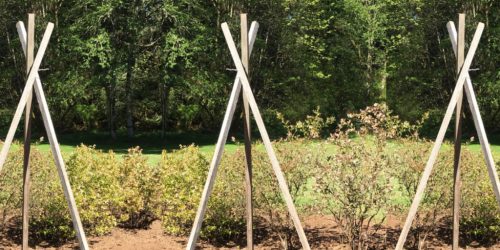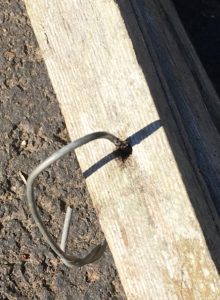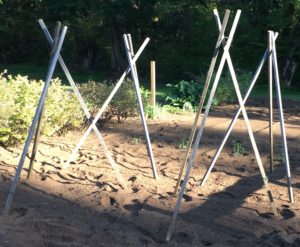Learn how to make a DIY pole bean trellis tower the easy way with this simple bean tower DIY project. This is one of the best pole bean support ideas because it’s fast, and best of all, the bean towers fold up for easy storage. These bean pole trellis towers are portable, reusable, and add a vertical element to our vegetable garden. Another advantage to making these easy DIY pole bean trellis towers is you can make them out of scrap lumber and wire. They didn’t cost us a penny. Looking for pole bean trellis ideas? Think learning how to make a bean tower is complicated? Not so! Growing pole beans can be fun and rewarding. Here’s how to make a pole bean trellis tower with step-by-step instructions. With these easy directions for this pole bean idea, you will learn how to make bean poles in no time!
This post contains affiliate links, which means I may earn a small commission from qualifying purchases at no additional cost to you. Please read my Policies page for more information.
Table of Contents
My Bean Trellis Teepee Tower Backstory
Over the past decade, as we became empty nesters, my husband and I needed less garden produce to feed our family. I have now transformed the vegetable garden into more of a combination vegetable/flower garden. I grow just as many ornamentals and flowers as I do vegetables. One amazing vegetable, the scarlet runner bean, doubles as an edible vegetable and an ornamental plant. In order to grow these beauties, I needed a sturdy, yet portable support. Hence, the need for a pole bean trellis teepee tower. No matter what kind of pole beans you grow, this is one of the best green bean trellis ideas because it is so quick and inexpensive.
DIY Pole Bean Trellis Tower Essentials
Before you embark upon your own DIY pole bean trellis project, it’s important to know what kind of pole bean trellis would fit your needs. Here are some common questions answered to help spark your own pole bean trellis ideas.
What Are Bean Towers?
Some people call them pole bean towers, some people call them green bean towers. The beans I grow on my DIY bean trellis are scarlet runner beans, as previously noted. That’s why I just call this three-legged, portable contraption a pole bean tower. It’s useful for growing pole beans because it gives them a way to grow vertically. These pole bean towers also make the beans easier to pick. So whether you call it a green bean tower, green bean trellis, or bean trellis teepee tower, the idea is the same.
Do Pole Beans Need a Trellis?
Yes, pole beans do need a trellis or some type of support to grow properly. Unlike bush beans, which grow close to the ground and do not need support, pole beans are climbing plants that grow upward and require a structure to climb on. Without a trellis or other pole bean support, the pole beans may grow along the ground, which can make them more susceptible to disease, pests, and damage. Additionally, pole beans grown without support may produce fewer beans or may produce beans that are of lower quality, as they will not have as much access to sunlight and air circulation as they would if they were grown on a trellis. Therefore, it is recommended to provide some type of support for pole beans, such as a trellis teepee tower or other structure, to ensure optimal growth and production. This DIY green bean trellis might be just the thing you need.
What is the Best Trellis for Beans?
When you are looking for bean pole ideas, keep in mind that the best pole bean trellis for green beans will depend on the specific variety of green beans you are growing, as well as your garden space and personal preferences. Pole bean supports can come in many shapes and sizes. Here are some pole bean trellis ideas that are commonly used for growing green beans:
A-Frame Trellis: An A-frame trellis is a simple and sturdy option for supporting green beans. It consists of two vertical poles that are connected at the top by a horizontal beam. The green bean vines can climb up the sides of the trellis and hang down in the middle, making it easy to harvest the beans.
Teepee Trellis: A teepee trellis is another popular option for growing green beans. It is made by planting several poles in a circle and tying them together at the top to form a cone-shaped structure. The green bean vines can climb up the poles and form a lush canopy of foliage and beans. This example is what this DIY post is all about.
T-Post Trellis: A T-post trellis is a good choice if you have a large garden space and want to grow a lot of green beans. It is made by driving T-posts into the ground at regular intervals and stringing a wire between them at the desired height. The green bean vines can climb up the wire and be trained to grow in a straight line.
Fence Trellis: If you have a sturdy fence in your garden, you can use it as a trellis for green beans. Simply tie some twine or string to the fence and run it horizontally between posts or stakes. The green bean vines can climb up the twine and produce a bumper crop of beans.
No matter which of these green bean support ideas you choose, make sure it is tall enough to support the full height of your green bean plants, which can grow up to 8 feet tall depending on the variety. Also, make sure the trellis is sturdy enough to withstand strong winds and heavy bean vines.
How Tall Should a Trellis be for Pole Beans?
A pole bean trellis height should be at least 6-8 feet (1.8-2.4 meters) tall. This will allow the beans to climb up the trellis and reach their maximum height without crowding or tangling. If the trellis for beans is shorter than this, the beans may grow too densely, which can lead to problems such as poor air circulation and increased risk of disease. Additionally, if the trellis is too short, the beans may start to grow on top of each other and become tangled, which can make harvesting difficult. Therefore, it’s best to make sure the trellis is tall enough to accommodate the height of the pole beans. If you are in need of a short bean pole idea, perhaps consider the fence trellis idea listed above.
Do Pole Beans Climb Clockwise or Counterclockwise?
Pole beans do not have a specific climbing direction or preference for clockwise or counterclockwise climbing on a garden bean trellis. The direction in which pole beans climb is actually determined by the structure they are climbing on, and not by any inherent tendency in the plant itself.
Pole beans use their tendrils to climb up supports, such as trellises, teepees, or strings. As they climb, the tendrils will wind themselves around the support structure in either a clockwise or counterclockwise direction, depending on the direction of the first coil. Once the initial coil is made, the tendrils will continue to follow the same direction as they wind around the support structure.
This means that if you want your pole beans to climb in a specific direction, you can simply start the first coil in the desired direction. Alternatively, you can let the beans climb in whatever direction they choose, as it will not affect their growth or productivity.
Do You Have to Train Pole Beans to Climb?
While pole beans are able to climb on their own, it is still a good idea to train them to climb in the direction you want them to go, especially if you are growing them on a trellis or other support structure.
When you first plant your pole beans, it is a good idea to gently guide the vines towards the trellis or support structure so they can start climbing. As the plants grow, continue to train them by gently wrapping the vines around the trellis or tying them to the support structure. This will help the plants to grow upward and prevent them from sprawling across the ground, which can lead to tangled vines and difficulty in harvesting.
Training your pole beans to climb can also help to improve air circulation and sunlight exposure, which can reduce the risk of disease and increase the yield of your plants. Additionally, training your pole beans to climb can help to prevent damage to the plants caused by wind, heavy rain, or other environmental factors.
Overall, while pole beans are capable of climbing on their own, training them to climb can help to improve their growth and yield, and make it easier for you to care for and harvest your plants.
How Many Beans Will One Pole Plant Produce?
The number of beans that a single pole bean plant produces can vary depending on several factors, including the variety of bean, growing conditions, and the length of the growing season. However, on average, a single pole bean plant can produce between 1 to 2 pounds of beans over the course of a growing season.
It’s worth noting that the yield of pole beans can be increased by ensuring the plants receive adequate water, sunlight, and nutrients, as well as by regularly harvesting the beans when they are ready. If you pick the beans regularly, it will encourage the plants to produce more beans, which can increase the overall yield.
Another factor that can impact the yield of pole beans is the spacing between plants. To ensure optimal growth and production, it’s recommended to plant pole beans about 6 inches apart along the base of the trellis or support structure.
While the yield of a single pole bean plant can vary, with proper care and maintenance, you can expect to harvest a significant amount of fresh, delicious beans from each plant.
Can Cucumbers and Pole Beans Share a Trellis?
Yes, cucumbers and pole beans can share a trellis as long as the trellis is strong enough to support both plants and there is enough space for each plant to grow and produce. In fact, companion planting cucumbers and pole beans together can be beneficial for both plants, as they complement each other in terms of growth and nutrient requirements.
When planning to grow cucumbers and pole beans together, keep the following tips in mind:
Choose a strong and sturdy trellis that can support the weight of both plants. A trellis made of wood or metal is a good choice.
Plant the pole beans first, as they will take longer to germinate and grow than cucumbers. Plant them at the base of two legs of the teepee trellis. Plant four seeds around each leg, one bean seed on each side of the wood.
Once the pole beans have started to climb the trellis, plant the cucumber seeds or seedlings at the base of the third leg of the teepee trellis, following the same planting method as with the beans, one cucumber seed or seedling to each side of the wood.
As the plants grow, gently guide the cucumber vines up the trellis, making sure they do not tangle with the pole beans. You can use twine or plant clips to tie the cucumber vines to the trellis.
Water the plants regularly and fertilize them as needed. Pole beans and cucumbers both benefit from a balanced fertilizer with equal amounts of nitrogen, phosphorus, and potassium.
With proper care and maintenance, your cucumber and pole bean trellis can produce a bountiful harvest of both vegetables throughout the growing season.
Can These Pole Bean Towers be Used as Pea Towers?
You could use these towers as pea towers. Some people call them pole bean and pea towers. However, I found that when I used these towers with peas, the pea plants needed a little extra help to climb for some reason. I ended up winding some fishing line around the poles, and that helped.
Materials Needed for One Trellis Teepee Tower
Let’s get started with our project. If you have a garden logbook journal, you can print out these steps for eacy reference. We have four trellis teepee towers, and you may only need one. So here is what you will need for one easy DIY pole bean tower:
12 inches of 10-14 gauge wire ( It can be baling wire or fence wire if you have any of that around.)
Cutting pliers or wire cutters
3 lengths of 1.5-inch by 1.5-inch by 8 foot pieces of wood (We used cedar. Old deck wood is perfect, ripped on a table saw, if you have one.)
Directions
First, cut your wood to the specified size. If you have a small garden bed, you may choose to make the poles shorter.
Next, drill one hole completely through each pole, 12 inches down from the top.
After that, line the poles up side-by-side on the ground so that the holes are aligned.
Finally, thread the wire through the holes and twist to fasten.
That’s it! Spread the poles out and place the tower in your garden.
Portability
These garden towers are easy to move around and reposition. They work well on uneven, sloped ground, as we have in our garden. You could have them in the same spot each year, or place them in different locations. This is especially useful if you try to rotate your garden crops each year. You can plant beans, or whatever you choose to grow, in a different location every growing season.
Versatility
The towers are great for a variety of climbing plants in addition to pole beans, such as cucumbers and peas. We have used them most often for different varieties of pole beans. Scarlet runner beans, as noted previously, are by far the favorite. They provide ornamental interest to the vegetable garden space, and the bean seeds have a sort of smokey flavor that is excellent in recipes.

Easy to Store
The towers are easy to take down when the season is over. The poles come back together as soon as they are lifted out of the ground. We store ours standing up under the lean-to of our garden shed. The poles could also be laid flat and stored in a loft or near a garage wall. Anywhere out of the weather would work well.
Durability
We have had our garden towers for more than 15 years, and the cedar has held up well. We didn’t have to treat it with anything special. If you do observe any rot at the bottom of the poles, you can just trim off an equal amount of length on each pole.
Ready to Give These Easy Pole Bean Trellis DIY Towers a Go?
This easy DIY pole bean tower project is so simple. Since this pole bean support idea is inexpensive as well, maybe you would like to give it a try. If you do decide to make a tower of your own, I’d love to see pictures of your completed project and where you decide to place it in your garden.
Looking for More Garden Inspiration?
Gardening can lift the soul. If you are looking for some more garden inspiration in addition to pole bean support ideas, check out the other gardening ideas offered here. Whether you are into growing flowers, herbs, or vegetables, you will find DIY projects and tips. The featured plants are easy-care and low-maintenance. They are perfect for everyone from the novice to the master gardener. Here are a few ideas you might enjoy:
- Flower Container Ideas for the Artistically Challenged
- Dividing Dahlia Tubers With Confidence
- How to Plant Dahlias
- Growing Old Garden Roses
- Best Easy-Care Perennials
- Fabulous Flowering Shrubs
- Best Companion Plants for Rhubarb
Need to Get Your Garden Organized?
As a result of needing to keep track of garden tasks throughout the year, I decided to begin a garden planner notebook. It has a page for each month, along with notes pages. If a garden planner notebook seems like a good idea to you, good news! You can get it here!
Get the garden notebook!
May all of your gardening endeavors meet with great success!
Lisa Mitchell is a wife, mom, and school librarian who likes to grow fruit, vegetables, and flowers on her family’s small Pacific Northwest farm. To learn more about what this website has to offer, click on over to the Welcome page.
Want more great garden, food, or travel ideas? Follow FluxingWell on Pinterest, Facebook, Instagram, and X for the latest posts, tips, and inspiration.















What a great way to get excited about getting back into the garden! Thanks for sharing this DIY bean pole tip for providing trellises in the garden. Will definitely share!
You are most welcome. Thank you so much for sharing!
Oh this is such a cool DIY project for the garden! Thanks so much for sharing the detailed process here!
I am so happy to share this. It is one of my favorite things to put up in the garden each year.
Your instructions on a DIY pole bean trellis towers for a garden are outstanding. I’m considering adding a garden to my home she this will be a great addition. Thank you for the great idea!
You are so welcome. Yes, this would be a great addition to your new garden. May it be a wonderful success!
I don’t have a garden but I love your practical instructions on doing pole bean trellis towers for the garden. Great tips!
Thank you! It is a fun project with immediate results.
I love that they are so easy to take down and store over the winter months, and then pull out again next season! We’ll definitely have to consider those if we decide to expand our garden after this year.
Britt,
Yes, the portability and compactness are great features. If you expand your garden, I hope you get to try one, if it fits your gardening style. Thanks so much for your comment, and happy planting!
Lisa
Thanks for sharing this! I had ot save this as im working/ planning my garden.
Brenda,
Planning and working on a garden is a lot of work. Good luck as you plan yours out, and maybe one of these towers might work well in your plan. Thanks for your comment, and best wishes with your garden!
Lisa
This is such a great idea. Since living in the countryside, we have a garden to take care of. Thanks for sharing this post, I will definitely try to make this.
Marianna,
I’m so glad you might be able to use this idea. If you do, I’d love to see a picture of how it turns out and where you end up putting it. Thanks for commenting, and happy gardening!
Lisa
Thanks Lisa, for always providing great tips free of charge. I love that this is easy to do and durable.
Betty,
I’m happy to provide tips, and I’m glad you think they are great ones. Thanks so much for taking the time to read what I write!
Lisa
These are a great and simple project! We are redoing our backyard so will have to remember these when we are ready to plant a garden!
Erin,
How exciting and ambitious to be redoing your backyard. I’d love to see pictures, and I hope you get to use the tower idea at some point. Thanks for your comment, and good luck with your backyard project!
Lisa
I’m hoping to get back into gardening this year. One of our biggest struggles was keeping the beans off the ground. I love this simple solution! Thanks for the great idea!
Jenn,
I hope you are able to get back into gardening, and if this tower idea helps, terrific! Thanks for taking the time to read and comment. Good luck with your many DIY projects!
Lisa
Wow, such a simple project. I really want to try my hand at gardening, but I fear that I will be a failure at it. I am thinking of possibly starting out with a few containers, and then transitioning to a full-size garden if all goes well. This will certainly be an awesome DIY project for the hubby if we do make that decision.
Lasonia,
If you are interested in growing herbs, those are great for containers. Chives are easy to grow, and come back every year. Tomatoes are another plant that a lot of people grow in containers. Good luck with whatever you try, and thanks for your comment!
Lisa
Wow these are perfect! I was looking for an easy durable way for my little climbers! Thank you!
Holly,
I’m so glad! If you do try these, I’d love to see pictures of your results. Thanks for your enthusiastic response!
Lisa